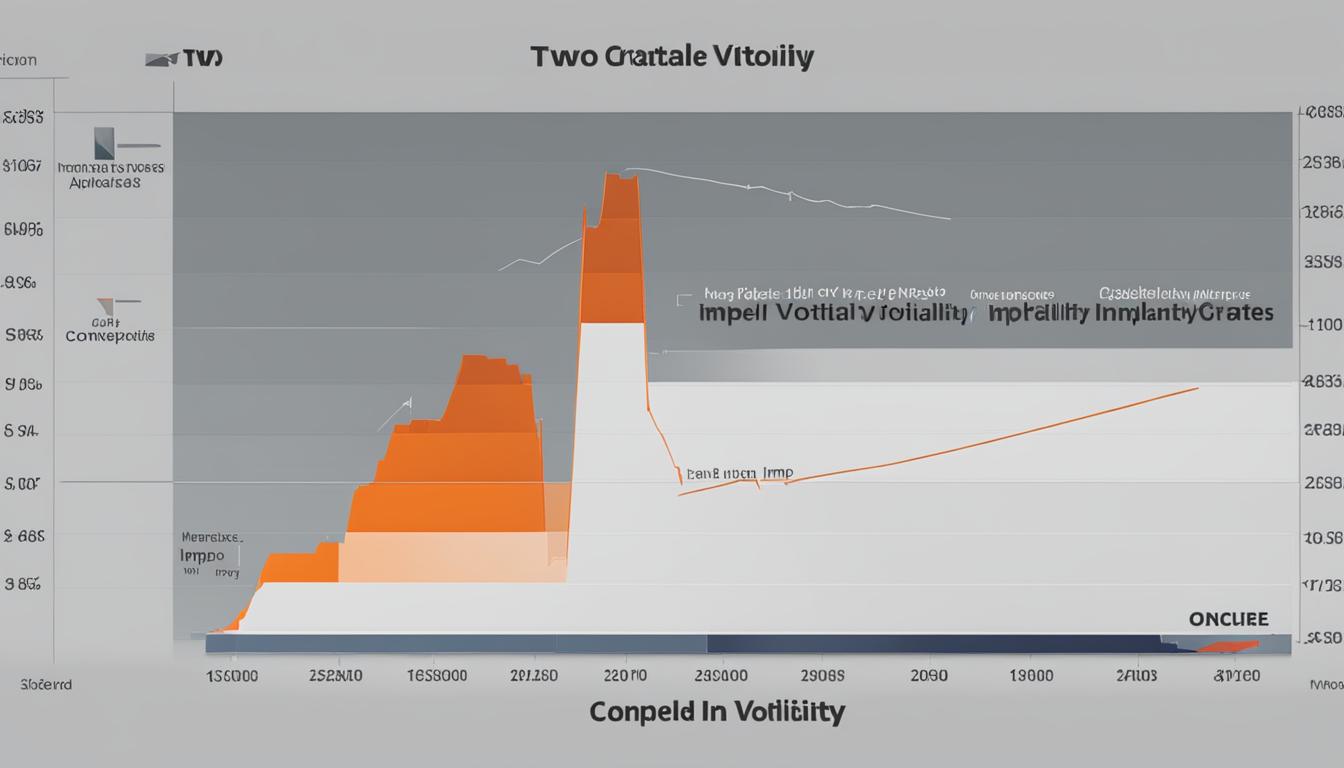5 Ways Inflation Changes the Game for Options Traders

Introduction
Options trading involves buying and selling options contracts, which give traders the right—but not the obligation—to buy or sell an asset at a specific price. This trading strategy is highly affected by inflation. Inflation can:
- Decrease the value of a portfolio
- Impact options pricing
- Introduce more volatility into the market
Key Takeaway: In this article, we will explore how inflation affects options trading. We’ll look at ways to reduce risks and take advantage of opportunities when there’s inflation.
Understanding how inflation and options trading are connected is important for making smart choices. Inflation affects different parts of options trading strategies, including how prices change and how much the market swings. By understanding these things, traders can navigate an inflationary environment better.
For more information on similar topics, you may find these resources useful:
- Unveiling the Hidden Power of Open Interest in Option Contracts: Learn about the importance of open interest in option contracts. Get insights into what investors are thinking and current market trends for better investment decisions.
- Consequences of Decreasing Implied Volatility: Find out how decreasing implied volatility affects your investments. Discover strategies to manage risks and make the most out of a changing market.
- What Is A Call Option?: Get a detailed understanding of Call Options with our complete guide. Learn how they work, their advantages, and how to use them effectively.
In the next sections, we’ll go deeper into understanding how inflation impacts options trading and explore practical strategies to manage associated risks.
1. Understanding How Inflation Affects Options Trading
Inflation can have a significant impact on various aspects of options trading strategies. When inflation goes up, the value of money decreases, which can result in higher expenses and changes in consumer spending habits. These changes can affect the volatility and pricing of options.
Key Components Affected by Inflation:
- Option Premiums: Inflation often causes option premiums to rise because of higher expected volatility.
- Time Decay (Theta): Inflation can speed up time decay as higher interest rates lower the current value of future cash flows.
- Strike Price Adjustments: Traders may have to make changes to strike prices to match the new market conditions caused by inflation.
Understanding how inflation relates to monetary policy and interest rates is essential. Central banks usually respond to increasing inflation by raising interest rates. Higher interest rates generally result in:
- Higher Cost of Borrowing: This can decrease profits for businesses and impact stock prices, which in turn affects related options.
- Increased Volatility: Uncertainty in the market grows as traders speculate about what central banks will do, leading to changes in option prices.
Tip: For a deeper understanding of market indicators, you can check out resources like Master the Market with the RSI Indicator. It offers a comprehensive guide on how to use the RSI indicator effectively and gain an edge in the market.
By grasping these dynamics, you’ll be able to create more knowledgeable and flexible trading strategies when inflation is high. It’s also important for traders to test their strategies in real market conditions instead of just using paper trading simulations. This exploration of complexities allows traders to assess the advantages and disadvantages, step out of their comfort zones, and ultimately improve their trading abilities.
Additionally, traders should be mindful of potential risks that can arise from broker errors. Understanding the most common types of broker errors and their impact on investments is crucial for safeguarding your portfolio.
2. The Role of Volatility in Inflationary Environments
Volatility plays a crucial role in options trading, especially when there’s a lot of uncertainty about inflation. Inflation can have a big impact on market stability, leading to unpredictable price changes and heightened volatility. For options traders, accurately predicting and adjusting to these changes is essential for making profitable trades.
Understanding Volatility’s Influence
- Effect on Options Trades: Volatility significantly affects the pricing of options. When volatility is high, options become more expensive due to the increased risk of large price movements. Traders must anticipate these shifts to capitalize on opportunities and maximize profits.
- Market Volatility Changes: Expectations surrounding inflation often trigger substantial fluctuations in market volatility levels. Heightened concerns about inflation rates create an atmosphere of uncertainty, resulting in increased volatility.
Challenges and Opportunities
- Challenges: Sudden spikes in volatility can erode the value of existing trades, making it difficult for traders to manage their portfolios effectively. This unpredictability hampers their ability to forecast price movements.
- Opportunities: Conversely, periods of heightened volatility present opportunities for traders who accurately forecast market behavior. Strategies like momentum trading thrive in such conditions.
By comprehending these dynamics, traders can develop better strategies that account for both systemic risks affecting the entire market and idiosyncratic risks impacting specific trades. To delve deeper into these risks, understanding Systematic vs Unsystematic Risk is crucial.
It’s equally important to note that options exchanges play a pivotal role for traders by enabling them to leverage market conditions optimally. If you’re curious about the functioning and significance of these exchanges, explore Options Exchanges.
To succeed during periods of significant price fluctuations, closely monitoring inflation trends and adjusting strategies accordingly is paramount. This allows traders to transform potential problems into profitable opportunities. Furthermore, if you aspire to enhance your trading prowess, delving deeper into Momentum Trading Techniques could provide a substantial advantage.
For a more in-depth understanding of volatility’s role in financial markets, including its impact on options trading, you can refer to articles like those found on Investopedia or academic research papers such as this one on volatility dynamics.
3. Risk Management Strategies for Options Traders Dealing with Inflationary Risks
Options traders who are dealing with inflationary risks need to have strong risk management techniques in place. Inflation can bring about volatility and unpredictability, which is why it’s important to have a strategic approach to protect your investments.
Key risk management strategies to consider:
- Diversification: Spreading out your investments across different types of assets can help reduce the impact of inflation on any one position.
- Hedging: Using options contracts like puts and calls can act as insurance against unfavorable market movements, especially during times of high inflation.
- Position Sizing: Adjusting the size of your trades based on the perceived level of risk can assist in managing potential losses.
Monitoring important economic indicators is crucial for effective risk assessment. Indicators such as the Consumer Price Index (CPI), Producer Price Index (PPI), and interest rate announcements provide valuable insights into inflation trends. By staying informed about these indicators, you can make better predictions about market movements and make necessary adjustments to your strategies.
Specific tools and methods include:
- Economic Calendars: Keeping track of significant economic releases helps you anticipate how the market will react to new data.
- Technical Analysis: Examining past price movements and patterns can give you clues about future volatility.
- Fundamental Analysis: Assessing larger-scale economic factors, such as government policies and global economic conditions, helps you understand the broader dynamics of the market.
For a more comprehensive understanding of these concepts and to improve your trading strategies, check out Master the Art of Rolling Options. This guide will show you how to effectively use rolling options to increase profits and take your trading strategies to the next level.
By understanding these risk management techniques, you’ll be able to navigate the complexities of options trading during times of inflation more effectively. Being alert and adjusting your strategies will ensure that you’re well-prepared to handle the uncertainties that come with it.
In addition to these strategies, it’s also important to familiarize yourself with essential components of options trading. For example, options quotes are crucial for decision-making, and understanding them is key to making informed trades. Similarly, learning about put options, which are strategic tools for investors in the U.S stock market, can provide insights into potential perks and advantages.
Remember, risk management should be an ongoing process that adapts to the changing market conditions. By implementing these strategies and staying informed about economic indicators, you can better navigate the uncertainties posed by inflationary environments in options trading.
4. Impact of Inflation on Options Pricing and Trading Approaches
Influence on Pricing Dynamics
Inflation significantly affects how options contracts are priced, including their intrinsic and extrinsic values. Here’s a breakdown of how inflation impacts these values:
Intrinsic Value
The intrinsic value of an option is directly linked to the price of the underlying asset. When there’s inflation, the cost of goods and services tends to rise, which can drive up the prices of underlying assets. This increase in asset prices boosts the intrinsic value for call options (options to buy) while decreasing it for put options (options to sell).
Extrinsic Value
The extrinsic value, also known as time value, is influenced by factors such as volatility and interest rates, both of which are affected by inflation:
- Volatility: Inflation can lead to increased market volatility as investors become uncertain about future economic conditions. Higher volatility generally translates to higher option premiums, increasing the extrinsic value.
- Interest Rates: Central banks often raise interest rates in response to high inflation to control its impact on the economy. This increase in interest rates typically raises the cost of holding long positions in options, thereby reducing their extrinsic value.
Practical Trading Strategies
Traders can use various strategies to adjust to changing inflationary conditions:
- Adjusting Position Sizes: By reducing their position sizes, traders can limit potential losses caused by unexpected spikes in inflation.
- Utilizing Alternative Pricing Models: Traditional pricing models like Black-Scholes may not fully account for the effects of inflation. Using models that consider changing interest rates and volatility can provide more accurate pricing estimates.
- Exploring Neutral Strategies: Implementing neutral strategies such as straddles or strangles allows traders to potentially profit from increased volatility without taking a specific view on the direction of the underlying asset.
Additional Resources for Neutral Strategies and Selling Options
For more insights into neutral strategies, consider checking out Boost Your Portfolio with Neutral Options Strategies, which provides a winning edge in the world of trading by offering a variety of strategies suitable for any market conditions. Additionally, selling options can be an effective approach in certain inflationary scenarios.
Timing of Option Exercise and Inflation
During periods of inflation, understanding when to exercise an option becomes crucial. Deciding whether to exercise early or hold until expiration involves assessing various factors such as the remaining time value, potential dividend payments (for equity options), and the cost of carrying the position.
Additional Resource for Option Exercise Explanation and Energy Primer
For a deeper dive into the intricacies of this subject, you can visit What Does To Exercise An Option Mean?, which explores the phrase “exercise option meaning” in financial parlance and its impact on daily life. Furthermore, it’s important to have a comprehensive understanding of energy markets as well, and resources such as this energy primer can provide valuable insights in that regard.
Adap
5. Top Inflation Hedging Techniques for Options Traders
Inflation hedges are essential for safeguarding your portfolio from the negative effects of rising prices. There are several strategies you can use to minimize these risks, especially those that are influenced by changes in interest rates.
Interest Rate-Sensitive Approaches
- Zero-Coupon Swaps
- Advantages: Provides direct protection against inflation by locking in a fixed return relative to an index like the Consumer Price Index (CPI).
- Limitations: It can be complex and costly compared to simpler instruments like Treasury Inflation-Protected Securities (TIPS).
- Inflation-Linked Bonds (e.g., TIPS)
- Advantages: Directly linked to inflation rates, offering a reliable hedge.
- Limitations: Lower returns compared to other riskier asset classes and limited availability for buying or selling.
- Interest Rate Options
- Advantages: Flexibility to profit from changes in interest rates, which often move in tandem with inflation expectations.
- Limitations: Requires advanced knowledge to use effectively.
Trading Tactics
- Adjusting Position Sizes: Smaller positions can reduce exposure during periods of high uncertainty about inflation.
- Utilizing Alternative Pricing Models: Incorporate models that take into account expectations of inflation and projections of interest rates.
Understanding these techniques and how they can be applied will improve your ability to navigate successfully through times of inflationary pressure. For more detailed information on advanced strategies, you can refer to our guide on Option Moneyness, which explains important concepts and advanced strategies for maximizing profits in the US market.
It’s also important to be aware of potential dangers such as Broker Scams, which can have serious consequences for your investments. Take the time to learn about the most notorious scams that have been uncovered and discover tips on how to protect your investments.
Maintaining a diversified portfolio and staying informed about macroeconomic factors are key for managing the potential impact of inflation on options trading.
Conclusion
Options traders must stay vigilant in monitoring inflationary trends. Proactively adjusting trading strategies in response to changing economic indicators is crucial for success.
Maintaining a diversified portfolio plays a vital role in managing the potential impact of inflation on options trading. Staying informed about macroeconomic factors allows for more informed decision-making.
Key Recommendations:
- Monitor Inflation Trends: Use tools like CPI reports and inflation forecasts to stay ahead.
- Adjust Trading Strategies: Adapt positions based on inflation expectations and market volatility.
- Diversify Portfolio: Incorporate various asset classes to mitigate risk.
- Stay Informed: Keep up with macroeconomic factors influencing inflation and market dynamics.
For further insights, you can explore the contrast between historical volatility vs implied volatility. Understanding these concepts will help you uncover how past market trends and expected fluctuations shape your trading strategy.
It is also essential to comprehend the intricacies of options settlement. This understanding will enable you to navigate the world of options trading with ease, as you become familiar with the procedures involved in closing contracts.
In addition, it is crucial to uncover the influence of trading halts on options trading. By doing so, you will be able to mitigate risks associated with such situations and navigate the complex world of options trading more effectively.
An ongoing analysis of effects of rising inflation on options trading will empower you to make strategic decisions, ensuring resilience and profitability in your trading endeavors.







